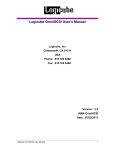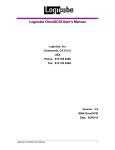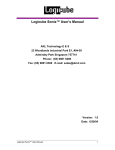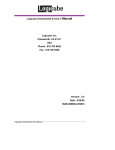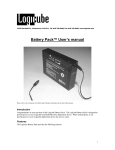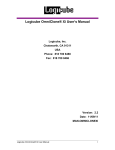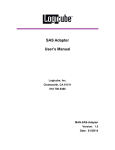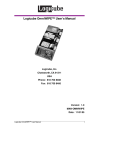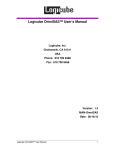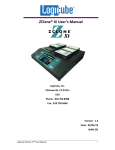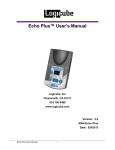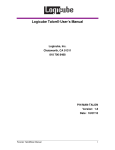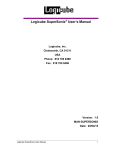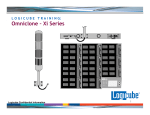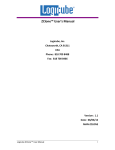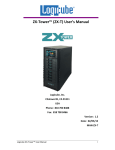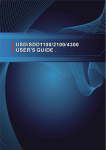Download Logicube OmniSCSI™ User`s Manual
Transcript
Logicube OmniSCSI™ User’s Manual Logicube, Inc. Chatsworth, CA 91311 USA Phone: 818 700 8488 Fax: 818 700 8466 Version: 2.2 Date: 9/11/08 Logicube OmniSCSI™ User Manual I TABLE OF CONTENTS Table of Contents LOGICUBE OMNISCSI™ USER’S MANUAL ............................................I TABLE OF CONTENTS.............................................................................II 1. INTRODUCTION TO THE LOGICUBE OMNISCSI™ ...........................1 Introduction ......................................................................................... 1 What Are Partitions?....................................................................... 2 Features.......................................................................................... 2 Using this guide .............................................................................. 3 System description ......................................................................... 3 2. GETTING STARTED (FAST START)....................................................5 Applying power to the Logicube OmniSCSI™ ................................. 5 Connecting Drives to the OmniSCSI™........................................... 5 Things to remember:....................................................................... 6 Adapters for other types of SCSI drives ......................................... 6 Adapters for other types of IDE drives............................................ 7 Power and Reset buttons ................................................................... 7 The user interface ............................................................................... 8 “Shortcut” buttons (available at all times) ....................................... 9 “Soft” Buttons .................................................................................. 9 “Navigation” (Arrow) Buttons .......................................................... 9 Indicator Lights ............................................................................. 10 3. CLONING MODES AND SETTINGS ..................................................11 Main Menu Screen............................................................................. 11 About Screen ................................................................................ 11 Drive Info ...................................................................................... 11 Screen Contrast............................................................................ 11 Cloning ............................................................................................... 12 Using the OmniSCSI™ ................................................................. 12 Clever Clone™ Mode ................................................................... 13 Clever Clone™ Step-by-Step ....................................................... 13 Logicube OmniSCSI ™ User’s Manual - II - INTRODUCTION Selective Partitions™ Mode.......................................................... 14 Selective Partitions™ Step-by-Step ............................................. 15 Mirror Clone™ Mode .................................................................... 17 Mirror Clone™ Step-by-Step ........................................................ 17 Master Manager™ Mode .............................................................. 18 Master Manager™ Step-by-Step .................................................. 18 Optional Preference Settings........................................................... 19 Verify............................................................................................. 19 Verify Settings............................................................................... 20 CHS Translation ........................................................................... 20 CHS Translation Settings ............................................................. 20 Security Identification Number (SID) Issues................................. 21 4. OMNIDIAGNOSTICS™ ......................................................................22 Introduction ....................................................................................... 22 Enabling OmniDiagnostics™ ........................................................ 22 OmniDiagnostics™ Features ........................................................... 23 Erase™ Target Mode ................................................................... 23 Erase™ Settings........................................................................... 23 Erase™ Target Step-by-Step ....................................................... 24 5. SOFTWARE LOADING INSTRUCTIONS ...........................................25 Logicube OmniSCSI™ Software Updating Procedures ................ 25 Loading Software Through with USB Thumb Drive...................... 25 Loading Software to the OmniSCSI One to One™ ...................... 25 6. FREQUENTLY ASKED QUESTIONS AND ANSWERS .....................27 7. INDEX .................................................................................................30 Logicube OmniSCSI ™ User’s Manual III 1. Introduction to the Logicube OmniSCSI™ Introduction Congratulations on your purchase of the Logicube OmniSCSI™. You are now the proud owner of a state-of-the-art SCSI disk cloning device. The OmniSCSI™ is designed to be easy enough to be used by a novice, yet offers many professional features that are not available anywhere else. The Logicube OmniSCSI™ copies the contents of 1 one hard disk drive to one or more others . The first drive is typically called the Master, while the other two are termed Targets. It performs the copy at speeds that are typically 4 to 16 times faster than they would be on a PC. The OmniSCSI™ first analyzes the partitions on the Master, then acts according to a user set mode. Depending on the mode, the unit will adjust structures to ensure the validity of the Targets. This process is called disk cloning. 1 The Logicube OmniSCSI™ is available in 1, 2 and 4 Target drive configurations. Logicube OmniSCSI™ User Manual 1 INTRODUCTION This manual covers the following Logicube products: OmniSCSI One-to-One™, OmniSCSI-2™ and OmniSCSI-4™ What Are Partitions? Partitions are areas on the drive that define a storage unit. Each partition is represented by a drive letter at the operating system level (e.g. C:, D:,...). For that reason, partitions are commonly called logical drives, or volumes. A partition is also associated with a file system, or a structure for laying out files on the partition. We will use the four words interchangeably throughout this manual. Hundreds of different types of file systems have been designed through the years. Only a handful are in common use. Among those are FAT16, FAT32, and NTFS. FAT16 – The file system used by DOS since version 3.3. This file system can be at most 2GB in size, and can be used under Win95/98, Win2000, and Windows NT. It is still the most widely used file system. FAT is the acronym of File Allocation Table, with entries that are 16 bit wide, hence the FAT16 name. FAT32 – Supported by Win98 and Win2000. Entries in the FAT are 32 bits each thus eliminating the 2GB limit and offering an improved space efficiency. NTFS – In use by Windows NT, and now Win2000. Offers improved access speed, and some security and recoverability features. The Logicube OmniSCSI™ is “aware” of the above three file systems and will clone them over “intelligently”. Features • Clones most SCSI drives 2 • The OmniSCSI™ 2 and 4 Target models can also use IDE, EIDE or Serial ATA drives as the Master. • Data transfer rates in excess of 2.5 GB/min. 2 2 As of this writing, SCSI “Fibre Channel” drives as well as 2.5” SCSI-2 laptop drives are not supported. Logicube OmniSCSI™ User’s Manual INTRODUCTION • Master and Target drives can be of different size, make and model. • Master drive can contain up to 24 partitions. • Automatically scales FAT16/32, NTFS 4.0/5.0/6.0, and Windows 2000/NT/ME/XP partitions. • Optional diagnostics software for Department of Defense (DoD) specification data wiping. Using this guide This user guide is made up of 8 sections: • Introduction • Getting Started (Fast Start) • Cloning Modes and Settings • Omnidiagnostics™ • Software Loading Instructions • Frequently Asked Questions • Index Please read Modules 1. Introduction, and Module 2. Getting Started before attempting a drive cloning session. It is recommended that you practice with a scratch drive to fully appreciate all of the features. System description The complete Logicube OmniSCSI™ system includes the following: • The Logicube OmniSCSI™ unit. • For the OmniSCSI One-to-One™, two (2) 68-pin flat ribbon cables and two (2) drive power cables are provided. • For the OmniSCSI-2™, three (3) 68-pin flat ribbon cables, one (1) 40-pin flat ribbon IDE cable and three (3) drive power cables are provided. • For the OmniSCSI-4™, five (5) 68-pin flat ribbon cables, one (1) 40-pin flat ribbon IDE cable and five (5) drive power cables are provided. • One (1) 25-pin “laplink” cable which is used to update the unit’s embedded software. Logicube OmniSCSI ™ User’s Manual 3 INTRODUCTION • An AC power cord. • A floppy disk containing: A. A backup copy of the software that is already pre-installed on the Logicube OmniSCSI™. B. Software update utilities necessary to load the software on the unit. • This manual. NOTE: Please contact Logicube Technical Support at (818) 700-8488 X3 if any of the above pieces are missing. Caution: Avoid dropping the Logicube OmniSCSI™ or subjecting it to sharp jolts. When in use, place it on a flat surface. Caution: Keep the unit dry. If you need to clean your Logicube OmniSCSI ™, use a lightly damp, lint free cloth. Do not run the cloth over the top cooling grid as moisture could get inside the unit. Avoid using soap or other cleaning agents particularly those containing bleach, ammonia, alcohol or other harsh chemicals. Caution: Do not attempt to service the Logicube OmniSCSI ™ yourself! Doing so may void the warranty. 4 Logicube OmniSCSI™ User’s Manual 2. Getting Started (Fast Start) Applying power to the Logicube OmniSCSI™ The Logicube OmniSCSI™ is able to detect the capacity, C/H/S stats and the partition table of any SCSI drive that is attached to the Master or Target positions. The OmniSCSI-2 and 4 models can also detect the same settings on any IDE/EIDE/SATA drive that is attached to the IDE Master position. NOTE: Never “daisy chain” more than one SCSI drive to each Master or Target position. The unit can only handle one drive on each position. Before applying power perform the following steps listed and refer to Figure 1 below. Connecting Drives to the OmniSCSI™ 1. If you have an OmniSCSI One-to-One™, proceed directly to step 5, for the OmniSCSI-2 and 4, continue to Step 2 below. 2. The unit comes with a cover that can be closed when the unit is copying drives to reduce noise. The cover can also be easily removed if desired. 3. You will notice that there is a corresponding data and power connector for each of the Target drive positions. The Master position has both an IDE and SCSI data connector along with a single power connector. NOTE: The Master position can hold a single drive – IDE or SCSI, but not both at the same time. 4. To attach an IDE Master drive, plug the 40-pin IDE ribbon cable into the IDE socket such that the red line is near the power connector, (4-hole receptacle). Plug a drive power cable into the corresponding power receptacle. Logicube OmniSCSI™ User Manual 5 GETTING STARTED 5. Attach the opposite ends of the cables to the 3 Master IDE drive . NOTE: The drive will not actually be powered until a copy operation is started. 6. To attach a SCSI Master drive, plug the 68-pin ribbon cable into the SCSI data socket such that the red line is near the power connector, (4-hole receptacle). Plug a drive power cable into the corresponding power receptacle. 7. Attach the opposite ends of the cables to the 4 Master SCSI drive . NOTE: The drive will not actually be powered until a copy operation is started. 8. Connect the remaining cables to their respective connectors for each Target drive position following the same information as step 6. Things to remember: The OmniSCSI™ supplies power to all drives during a cloning session. There is no need to connect an external power source to the drives. It is OK to connect and disconnect Master or Target drives while the OmniSCSI™ is powered and idle. However, do NOT connect or disconnect drives during a cloning session. The Status light will typically blink to indicate that the unit is cloning. Adapters for other types of SCSI drives Logicube sells specialized adapters that allow the following types of SCSI drives to be connected to the Logicube OmniSCSI™: • 80-pin Adapters for connecting drives with SCA-80 connectors.. • 50-pin Adapters for connecting drives with oldstyle SCSI-1 connectors. Other specialized adapters are also available. If you are unsure about the type of drive that you have, 3 Any IDE/EIDE drive attached to the OmniSCSI™ needs to be jumpered for Single Master. Please refer to your hard drive’s User Manual for specific jumper specifications. 4 SCSI drives can be set for any c, except 7, which is reserved for the SCSI Host Adapter. For best results, set each Target drive to SCSI ID 0, this will allow drive identification to proceed more quickly. 6 Logicube OmniSCSI™ User’s Manual GETTING STARTED please contact Logicube Technical Support for assistance. Adapters for other types of IDE drives Logicube sells specialized adapters that allow the following types of IDE drives to be connected to the Logicube OmniSCSI-2 or 4: • 2.5” Laptop Drives (also called Notebook drives). • 1.9” Laptop drives, (e.g. Toshiba Ipod™ drives). • Serial ATA (SATA) drives. Other specialized adapters are also available. If you are unsure about the type of drive that you have, please contact Logicube Technical Support for assistance. Power and Reset buttons Please refer to Figure 2 below. The Logicube OmniSCSI™ includes two On/Off switches and one reset button. One power switch is a rocker switch that is located on the unit’s power supply. The other power and reset buttons are located on the back of the unit. Looking at the back of the OmniSCSI, the reset button is on the right and the power button is on the left, (near the power supply). When the unit needs to be soft-booted (or power cycled), press the reset button and hold it in momentarily. Wait a couple of seconds and let go, the unit will reboot and be ready to use in 30 seconds. NOTE: User settings are retained after the unit is restarted. When the unit needs to be hard-booted, tap the power button. This will shut the unit off. Wait a few seconds for the drives to stop spinning, then tap the power button again. The unit will reboot and be ready to use in 30 seconds. NOTE: Please check the switch on the power supply to make sure that it is on. The power button will not function if the power supply switch is off. WARNING: Make sure that the AC Voltage slider on the power supply is set to 115V or 230V depending on Logicube OmniSCSI ™ User’s Manual 7 GETTING STARTED the AC Voltage outlets in your area, the unit could be damaged if the wrong Voltage is selected. (115V is used mostly in the US and Canada while 230V is used mainly in European countries. Please check with your local power supplier to be certain). Figure 2. Power and Reset buttons The user interface The user interface (UI) has been designed with the professional in mind. It is fast, responsive, and to the point; which means it requires very few key strokes to achieve a desired action. It also displays fewer “are you sure” messages that may slow down the cloning session. Please refer to Figure 3 as you read the information below. 8 Logicube OmniSCSI™ User’s Manual GETTING STARTED “Shortcut” buttons (available at all times) • START/STOP Button – Press it twice to begin a cloning operation using the current settings; press the START/STOP button in mid process to abort it. A single key stroke presents a preview screen where you can see the current setting, and decide whether to press it again to begin the capture, or back out to reconfigure. • The “Help” (”?”) button provides context sensitive help and is active at all times. Press it to get specific help on the current screen. If the selection cursor is on the screen, pressing the Help button will retrieve specific help for that item pointed to. The Help button also brings up a slider to adjust the screen contrast. • The “Set” button is the third “shortcut” button. It brings you to the settings screen where you can change capture modes and other settings of the unit. “Soft” Buttons The “soft” buttons are used anywhere selection or toggling are necessary. • The “Select” button is used to select an option (e.g. a partition to copy), to toggle between multiple available options or to enter a sub-menu. • The “Back” button is used to go “up” in the menu system or to cancel out of a given operation. “Navigation” (Arrow) Buttons The four Arrow buttons are used for navigation. • The “Up” and “Down” buttons are most often used when there is a scrollable window of text and the right side of the screen displays the scroll arrows. This occurs when the amount of information to display exceeds the screen size. There are also screens in the Settings menu where navigating from one option to another requires moving up or down. • The “Left” and “Right” buttons are used to navigate from one option to another in the Settings menu. The currently active option will be enclosed by a dashed rectangle. Logicube OmniSCSI ™ User’s Manual 9 GETTING STARTED Indicator Lights The POWER indicator light remains on while the Logicube OmniSCSI™ is receiving power. The STATUS indicator is lit during cloning operations and any operation that accesses the Master or Target drive. It will flash green as data is transferred from one drive to the other. An ERROR light will come on if a problem is encountered during cloning or any other operation. The Status Light will stop flashing and turn red. If this occurs, check the screen for an error message and instructions on what to do next. Figure 3. Buttons and Interface NOTE: The display panel will look slightly different between the OmniSCSI One-to-One™, OmniSCSI-2 and the OmniSCSI-4. Also, the Status Lights will show the number of Target drives that the unit can hold, (i.e. one Target light for the OmniSCSI One-toOne, four Target lights for the OmniSCSI-4, etc.) 10 Logicube OmniSCSI™ User’s Manual 3. Cloning Modes and Settings Main Menu Screen The main menu screen appears when the Logicube OmniSCSI™ is first powered up after it goes through the Self Test. It displays the Splash Screen and two menu options: About and Drives. About Screen Select the About Screen by highlighting “About” and pressing the Select button. It will display the serial number of your unit along with the software and firmware versions that are loaded. In addition, the About screen lists all options currently enabled on the unit and provides contact information for Logicube Technical Support. To return to the main menu, simply press the Back button at any time. Drive Info Select the Drive Info screen by highlighting “Drives” and pressing the Select button. After 30 to 45 seconds, the unit will show a list of all the drives it has detected. Use the arrow keys to navigate the list. When a drive is highlighted (and the Select button pressed), the unit will access the drive and report back the drive’s model number, capacity, geometry and other information. To see the drive’s partition information, highlight “See More” and press the Select button to display all of the partitions located on that drive. To return to the main menu, you may press the Back button at any time. Screen Contrast To adjust the contrast of the display, simply press the Help button at any time. Underneath the Help information is a slider bar to adjust the screen Logicube OmniSCSI™ User Manual 11 CLONING MODES AND SETTINGS contrast. Use the Left and Right arrows to adjust the bar. Once the desired contrast is set, press the Select button to return to the previous screen. Cloning Using the OmniSCSI™ The OmniSCSI™ can be in one of several modes of 5 operation . To set a mode hit the “Set” button, navigate to the top icon and hit the “Select” button. 6 You will now see the following screen : You will notice the three tabs along the top of this screen labeled “Clone”, “Tools”, and “Diag”. You can navigate between the three tabs when the dashed rectangle is around the label of each tab. For example, pressing the right arrow button when the dashed rectangle is around the “Clone” label will cause the “Tools” tab to become active and display the available tools. 5 Some of the modes are optional and require the purchase of a separate license. Call Logicube Sales for more details at (818) 700 8488. 6 Depending on the options you purchased and installed your screens may not match the examples exactly. 12 Logicube OmniSCSI™ User’s Manual CLONING MODES AND SETTINGS Pressing the right arrow again when the dashed rectangle is around the “Tools” label will cause the “Diag” tab to become active and display the installed 7 diagnostics . NOTE: At the end of the chapter will be a special discussion on dealing with SID (Security Identification) issues under the Windows NT, Windows 2000 and Windows XP operating systems. Clever Clone™ Mode This is the default mode. It clones ALL partitions on the Master drive to the Target drives, automatically deciding the fastest method possible for each partition found. It scales all known partitions (At this writing – FAT16/32, and NTFS) to fill the Target in its entirety and makes all the necessary adjustments to ensure valid and bootable Target drives. When this mode is selected the Set screen will present the following additional settings: Clever Clone™ Step-by-Step 1. From anywhere in the menu system click the “Set” button to enter the Settings menu. 2. Scroll to the top icon and click the “Select” button. The Modes screen appears. 3. Scroll to the “Clever” item (the light bulb icon), 8 and hit “Select” again . 7 If you did not purchase the Diagnostic option this screen will not contain any selectable items. 8 You may need to switch from another tab screen to the Clone tab to access this option. Logicube OmniSCSI ™ User’s Manual 13 CLONING MODES AND SETTINGS 4. Adjust the “Verify” and “CHS” settings as needed. (These settings are discussed later in this chapter). 5. You may now double-click the “Clone Now!” button to start cloning. NOTE: When Clever Clone™ scales down an NTFS partition, it can only scale it to 55% of the original size. Selective Partitions™ Mode This is the most elaborate and most flexible mode. It allows the highest level of control over the cloning process. Selective mode allows you to select one or multiple partitions to clone. It also allows you to choose a 9 unique copy method to use for each. The available methods are: Clever Clone™ – The default mode that lets the OmniSCSI™ determine the best (usually fastest) way to clone. It is denoted by the light bulb icon. It works with all FAT16/FAT32 and NTFS type partitions. (NOTE: NTFS CleverCopy is an optional feature and will only be available if purchased and installed on your unit.) Defragment – Forces the defragmentation of all partition data. This mode uses an advanced defragmentation algorithm to create a Target partition with no gaps and with contiguous files. It works with FAT16/FAT32. Defragmentation is a rather slow process and should be used only when a single copy is required of a given Master drive. In cases where multiple copies are desired, it is much better to use a defragmentation program on the PC for the Master and then move the Master drive onto the OmniSCSI™. Note that the Clever Copy™ mode will resort to the defragmentation method if the given partition is FAT16 and a cluster size change is required to create a valid Target partition. (Read more about cluster size later.) Partition Mirror – Simply streams over the full contents of the selected partition without allowing any partition scaling (Do not confuse this mode with the Mirror copy mode which mirrors the entire Master drive). This method is available for any partition type. This is the only method available to unrecognized partitions. Use this method for FAT16/FAT32 only if 9 Note that not all modes are available for all partition types. 14 Logicube OmniSCSI™ User’s Manual CLONING MODES AND SETTINGS the Clever or defragmentation methods fail due to inconsistencies of partition structures. Convert FAT16 to FAT32 – Converts the selected partition from FAT16 to FAT32 on the fly. This mode is available for FAT16 partitions ONLY. Use only when the given partition is to be used with Windows 98/2000. Some versions of Win95 and all versions of MS-DOS cannot access partitions that use FAT32. Selective Partitions™ Step-by-Step 1. From anywhere in the menu system click the “Set” button to enter the Settings menu. 2. Scroll to the top icon and click the “Select” button. The Modes screen appears. 3. Scroll to the “Selective” item (the painter’s 10 palette), and hit “Select” again . The MASTER drive will now power up. Some seconds later you will see a list of all partitions found on the MASTER. 4. On the right hand side you will see a designator for the partition type: • FAT16 - FAT16 partition • FAT32 - FAT32 partition • NTFS - NTFS partition • CQ - COMPAQ diagnostics partition • ?? - unknown partition 5. Use the scroll buttons to place the cursor by a given partition and press the “Select” button multiple times to cycle among the 5 options. (Clever -> Defrag -> Mirror -> Convert to FAT32 > <blank> -> back to Clever). See Figure 4 below. 10 You may need to switch from another tab screen to the Clone tab to access this option. Logicube OmniSCSI ™ User’s Manual 15 CLONING MODES AND SETTINGS Figure 4: Selective Copy Modes CleverCopy Use the CleverCopy algorithm for this partition Defragment Defragment this partition onthe-fly (FAT16/32 only) Mirror Simple partition mirror (no adjustments) Convert to FAT32 Convert this partition to FAT32 (applies to FAT16 only) None Do not copy this partition For example, look at the following screen: Here three partitions have been selected for cloning. The first has a volume label MY_WIN98_32, is a 5.0 GB FAT32 type, and will be defragmented as it is copied to the Targets. The second, MY_WIN98_16, is a 2.0 GB FAT16 and will be converted to FAT32 on the fly. The third, NTFS_WKS_40, is a 3.5 GB NTFS and will be Clever Copied to the Targets. 6. Scroll to other partitions and repeat the above step. Note that it is OK to assign unique cloning modes to each selected partition. 7. Adjust the “Verify” and “CHS” settings as needed. (These settings are discussed later in this chapter). 16 Logicube OmniSCSI™ User’s Manual CLONING MODES AND SETTINGS 8. When done, hit the “Start/Stop” button twice to start cloning. NOTE: When multiple copies are required, all you need to do is change the TARGET drives, and hit “Start/Stop” twice. Your last selections are used. If the unit senses that the MASTER drive was changed (by reading the serial number of the MASTER), it will again return you to the selection screen, where you specify the method of copy for each partition. NOTE: If you wish to change the last used settings (and the MASTER drive did not change), follow the “Selective Clone Step-by-Step” instructions above. Mirror Clone™ Mode This mode simply makes a bit-by-bit mirror copy of the Master drive. It does not adjust any values. This mode is only recommended when all else fails and even then only between similar geometry drives. It is also recommended for non-Windows partitions like UNIX, LINUX and other such systems. NOTE: Drives in a RAID array have dynamic or striped partitions and also need to be Mirror Cloned. When cloning a multiple drive RAID array, each drive in the array needs to be Mirror cloned to an identical Target drive. You can dial the percentage of Master disk you wish to mirror. For example, setting to 50% will mirror the first 50% of the Master drive’s size. Mirror Clone™ Step-by-Step 1. From anywhere in the menu system click the “Set” button to enter the Settings menu. 2. Scroll to the top icon and click the “Select” button. The Modes screen appears. 11 3. Scroll to the “Mirror” item and hit “Select” again . 4. Adjust the “Verify” and “CHS” settings as needed. (These settings are discussed later in this chapter). 5. A screen appears asking you what percentage of the Master drive to clone. Use the Up/Down scroll 11 You may need to switch from another tab screen to the Clone tab to access this option. Logicube OmniSCSI ™ User’s Manual 17 CLONING MODES AND SETTINGS arrows to adjust this value in increments of 5%. If less than 100% is chosen for the FRONT of the drive, the unit will also ask for a percentage from the REAR of the drive. 6. You may now double-click the “Clone Now!” button to start cloning. Master Manager™ Mode This is a special mode that assists in the creation of Master drives. It lets the user choose exactly one partition from the drive in the Master position (referred to henceforth as the Source drive) and clone it to the drive in the Target 1 position (referred to henceforth as the Destination drive). The Master Manager is a useful tool to aid in the creation of a multi-partition Master drive. Many MIS technicians like to store multiple partitions (e.g. one for accounting, one for marketing, etc.) on a single Master drive. When a new PC is to be configured or a drive crash occurs, all the technician needs to do is select that partition and clone it. The tool is also useful to create backups of important partitions. The OmniSCSI™ can hold up to 24 partitions on one Master drive. Drives over 250GB in size have been tested with Master Manager successfully. Master Manager prompts the user to select exactly one partition on the Source drive. It then prompts the user to either select an existing partition on the Destination drive to overwrite, or to append the selected partition at the first available space on the Destination drive. WARNING: Please use this mode with care as the Destination Drive (your multi-partition master drive) is altered in the process. Master Manager™ Step-by-Step NOTE: To create a Master drive using Master Manager, you must start with an unformatted drive. (Use the Erase™ Mode, FDISK or a third party tool to wipe out the intended drive’s partition table.) 1. From anywhere in the menu system click the Set button to enter the Set menu. 2. Scroll to the top icon and click the “Select” button. The Modes screen appears. 18 Logicube OmniSCSI™ User’s Manual CLONING MODES AND SETTINGS 3. Switch to the “Tools” tab. Scroll to the “Master Manager” item (the puzzle piece) and hit “Select” again. 4. Hit the “Start/Stop” button twice to start cloning. You will be warned that continuing will modify your Destination drive. If you are ready to do this, choose “Yes” to continue. 5. Both drives will now power up. After a few seconds the unit will display a list of all Source partitions. 6. Choose exactly one Source partition by placing the cursor by the desired partition. Hit “Select” to toggle among the cloning methods exactly as you would in “Selective” mode. 7. Hit “Clone Now!” 8. Now Destination partitions (if any) are displayed. 9. Place the cursor by a Destination partition you want to overwrite or scroll down to the “Add Partition” item. Hit “Select” to choose the desired partition or to add a new partition. 10. Hit “Start/Stop” to begin cloning. Optional Preference Settings In addition the different cloning modes, there are preference settings that can be used to adjust the behavior of the cloning operation. Each of these preference settings is accessible through the Settings menu, which can viewed at any time from anywhere in the menu system by pressing the Set button. NOTE: Not all preference settings are available in every cloning mode. Verify Many of the modes will allow you to use a sub-setting called “Verify”. If this mode is set, every sector written to the Target drives is read back and verified. This practically guarantees the validity of the Target drive data as well as scans for bad sectors. Without verification, the OmniSCSI™ cannot detect bad Logicube OmniSCSI ™ User’s Manual 19 CLONING MODES AND SETTINGS sectors on the Targets. Any data cloned onto bad sectors may be corrupt or incomplete. NOTE: With newer drives (manufactured in the last 2 years) this problem is virtually non-existent since the drives employ extensive on-the-fly bad sector detection and re-allocation. Engaging the verification feature slows the speed of cloning by a factor of two or more. If a bad sector is detected on the Targets (with Verify turned on), the cloning process will abort with an error message. NOTE: Logicube recommends against using drives with bad sectors as new defects are likely to develop. To use Verify, scroll to the Verify icon in the Settings Menu, and press the “Select” button. Verify is available in Clever, Selective and Master Manager modes. Verify Settings • None (Default) - No data verification is performed. • 100% - Full data verification is performed on each Target drive. CHS Translation CHS Mode sets the geometry (Cylinder, Head and Sector) translation used on each Target drive. CHS information is stored in the partition table of the hard drive and is used by the BIOS to determine from which partition to boot. The correct setting will depend upon the capacity of the Target drive and on the BIOS of the PC in which it will be used. Check with the hard drive and PC manufacturer to determine which CHS mode is best as different BIOS systems use different translation methods for large (over 528 MB) capacity drives. To use CHS Translation, scroll to the CHS icon in the Settings Menu, and press the “Select” button to scroll through the options. CHS is available in Clever and Selective Clone modes. CHS Translation Settings Following are the CHS modes supported by the Logicube OmniSCSI™: 20 Logicube OmniSCSI™ User’s Manual CLONING MODES AND SETTINGS LBA (Default) – This CHS Mode will work for most hard drive and PC combinations and should be used unless otherwise indicated. Large – Also known as Extended CHS (ECHS) mode. It is used on all Compaq and Samsung computers, some IBM PC’s, IBM Thinkpad laptops, some newer Dell laptops, and possibly other computers. It should also be used whenever a Phoenix BIOS version 4.0 or earlier is encountered. LBA 8.5 and Large 8.5 – These settings force all partitions to remain below the 8 GB mark. This is useful with Legacy motherboards that cannot support drives larger that 8.5 GB. LBA-1, LBA-2, Large-1 and Large-2 – These settings instruct the Logicube Sonix™ to “shave off” one or two cylinders from the total drive size when constructing the Target partition tables. NOTE: It is important to use -1 or -2 settings for all Windows 2000 and Windows XP installations. These operating systems use the unallocated space to store certain tables required for Active Directory and sometimes for Dynamic Partitioning. NOTE: Most of the time, blocking out one cylinder is enough but two may need to be blocked out to achieve good results. Security Identification Number (SID) Issues The Windows NT, Windows 2000 (previously known as NT 5.0) and Windows XP operating systems attach a SID (Security Identification) number to all files and directories on the hard drive for security and authentication purposes. The same SID numbers are found in the system registry in various locations. When such drives are cloned, the SID numbers get copied without change. If the Target drive participates in the same network as the Master, there will be a security breach, which will cause undesirable network behavior. To avoid this issue with Windows NT and Windows 2000, we recommend a freeware SID changer called NewSID. The latest version can be downloaded at www.sysinternals.com. Logicube is in no way associated with SysInternals and cannot offer any technical support for NewSID. Other commercial SID changers can also be found at major software outlets. For Windows XP, you must use Microsoft’s Sysprep utility, which is available as a free download from the Microsoft website at www.microsoft.com. Logicube OmniSCSI ™ User’s Manual 21 4. OmniDiagnostics™ Introduction The Logicube OmniSCSI™ has optional software 12 packages that are not part of the standard unit . Foremost of these is OmniDiagnostics™, an optional feature that allows Target drives to be wiped clean of data. Enabling OmniDiagnostics™ All optional software packages are already inside your Logicube OmniSCSI™ (and are automatically updated when you install a newer software version). To use an option like Omnidiagnostics™, it first needs to be enabled. To enable OmniDiagnostics™ on your Logicube OmniSCSI™, contact Logicube to purchase a license key that is unique to your unit. Once you have obtained the license key, follow this procedure to enter it into your Logicube OmniSCSI™ 7. Press and hold the Reset button. While holding it down, press and hold the “Start/Stop” button. Release the Reset button. 8. The OmniSCSI™ will display an “Entering Setup” message as it goes through the self test. 9. In the Setup Menu, Scroll to the “Enable Option” menu item and press the Select button. 10. Enter the OmniDiagnostics™ activation code you received from Logicube. 11. If all symbols have been entered correctly, the Logicube OmniSCSI™ will reboot to the main menu. 12 As of this writing, the only optional feature available is Omnidiagnostics. Other features may become available in the future. Check www.logicube.com periodically to keep abreast of new information. Logicube OmniSCSI™ User Manual 22 OMNIDIAGNOSTICS™ 12. To verify that OmniDiagnostics™ has been activated, go to the About Screen. You will now see OmniDiagnostics™ listed as an installed option. NOTE: Once the license key is entered, an optional software package is permanently enabled. The key will not need to be entered again, unless the Firmware or the BIOS are changed on the Logicube Sonix™ itself. NOTE: Loading new software updates will not disable the Omnidiagnostics™ option. OmniDiagnostics™ Features Erase™ Target Mode The Erase™ Target mode erases all data on the Target drive. This may be required when discarding drives that contain sensitive information to which you do not want others to have access, e.g. financial information, trade secrets, etc. Erase™ writes a pattern over the whole Target drive 2 X n+1 times, where n is the selected number of iterations of all 0’s and all 1’s. The last pass then writes the chosen pattern to every byte of the drive. For example, if you set the number of passes (the value of n in the above formula) to 1, WipeClean™ will perform a total of three passes, first writing all 0’s then again writing all 1’s. Then one more pass will be made this time writing the chosen pattern. Set the number of passes to 0 for a single pass of the chosen pattern. This method is acceptable for quickly wiping a drive where removal of sensitive information is not an issue. Set the number of passes to 1 and the pattern to RANDOM if you wish to erase data according to Department of Defense (DoD) specification M-5220. Erase™ Settings The following settings are used in configuring WipeClean™ Target mode: Passes – Determines how many iterations of all 0’s and all 1’s are performed. The default is 0. Set the value to 1 for compliance with DoD M-5220. Logicube OmniSCSI ™ User’s Manual 23 OMNIDIAGNOSTICS™ Value – Select the value to be written on the last pass. The options are 0xf6, 0x00, 0xff, and Random (DoD default). (The Random setting will fill the Target drive with a pseudo random pattern). Erase™ Target Step-by-Step 1. Attach the drive(s) to be erased to the Target position(s). Attach a scratch drive to the Master position. NOTE: Do not use an actual Master drive in the Master position. A pattern will be written to the beginning of the drive which will corrupt any data residing on it. 2. From anywhere in the menu system click the “Set” button to enter the Settings menu. 3. Scroll to the top icon and click the “Select” button. The Modes screen appears. 4. Scroll to the “Erase” item (in the Diag menu), and 13 hit “Select” again . 5. Adjust the “Passes” and “Value” settings as needed. (These settings are discussed in the previous section titled “Erase™ Settings”). 6. Press the Start/Stop button twice. 7. A message will appear stating that portions of your Target drive will be overwritten. If you are prepared to continue, choose “<Yes>”. If you wish to abort the operation, choose “<No>”. 8. If “<Yes>” is chosen, a second message will appear stating that you are about to erase the Target. If you wish to continue, choose “<Yes>”. If you want to abort the operation, choose “<No>”. 9. If “<Yes>” is chosen, the Erase™ Target operation will begin and a status screen will appear. 10. The Logicube OmniSCSI™ will notify you when erasing is complete. Press the Back button to return to the main menu. 13 The OmniDiagnostics™ option needs to be installed for Erase™ to be available. 24 Logicube OmniSCSI™ User’s Manual 5. Software Loading Instructions Logicube OmniSCSI™ Software Updating Procedures New and improved software will appear from time to time on our web site at www.logicube.com. It is possible to update the operating software in the field by a user. Loading Software Through with USB Thumb Drive NOTE: Loading or updating software through the use of a USB thumb drive is only possible on the SCSI One to One™. Download the current OmniSCSI One to One™ software from the Logicube web site to your PC. A copy of the software that shipped with your OmniSCSI One to One™ can also be found on the CD that shipped with your unit. Loading Software to the OmniSCSI One to One™ 1. Locate the OmniSCSI One to One™software entitled Omnidup. 2. Insert a USB thumb drive into an available USB port on your PC. 3. Copy the Omnidup file from the PC to the root directory of the USB thumb drive. 4. Press and continue to hold the START/STOP button while turning on the unit. Release the START/STOP button only after you hear a beep sound. The display will show the Setup Menu on the OmniSCSI One to One™ after approximately 90 seconds. Move the cursor to Load New Software and press <SELECT>. 5. You will see the following message: Insert Thumb drive containing SW - Press <SELECT> to continue… Logicube OmniSCSI™ User Manual 25 SOFTWARE LOADING INSTRUCTIONS 6. Remove the cover plate located on the left side of the OmniSCSI One to One™ chassis and insert the thumb drive into one of the two USB ports. Wait 5 seconds for the thumb drive to be recognized. See Figure 5 for USB port locations. Figure 5. Thumb drive plugged into USB Port 7. Press <SELECT> 8. The display will read: “Searching for new S/W” followed by “Done Loading”. The update/load is now complete. NOTE: The thumb drive must be FAT32 formatted. NOTE: Please contact Logicube Technical Support at (818) 700-8488 X3 if you have any trouble with the software update. 26 Logicube OmniSCSI™ User’s Manual 6. Frequently Asked Questions and Answers Q. Why does the OmniSCSI™ emit one to four beeps when powered up? Is this Normal? A. Yes, this is normal. The beeps occur as part of the unit’s self test. Q. How does the OmniSCSI™ determine the size of partitions on the Target drive? A. In the default CleverCopy mode, all known partitions (FAT16/FAT32/NTFS) are scaled proportionally to the ratio of Master/Target size. All unknown partitions (e.g. HPFS, UNIX etc.) are mirrored, that is they maintain their size. Please note that FAT16 partitions cannot exceed 2.1GB when scaled up, nor be smaller than 32MB when scaled down. Q. Can the OmniSCSI™ defragment a partition? A. Yes. Use the Selective mode, scroll to the desired partition, and toggle the icon to the left of it until the defrag symbol appears. Hit the “Start/Stop” button twice to start the cloning session. Defragmenting is somewhat slower than other cloning methods, and is currently available for FAT16/FAT32 partitions only. Q. Can the OmniSCSI™ clone to dissimilar drives? A. Yes. The OmniSCSI™ will take care of all the necessary adjustments of Target drive structures to ensure the drive (of any size) will be valid and bootable. Many mixtures of Master and Target drive sizes (up to 300GB) were tested, and found to be valid. The above is true for all Master drives that contain FAT16/FAT32/NTFS type partitions. Unknown partition types are cloned in mirror mode, and typically require identical (or very similar) Master and Target drives to guarantee a successful clone. Q. Why do I sometimes see transfer speeds greater than 2.5GB/min., and other times as slow as 200MB/min.? A. There are many factors that determine transfer speed: • The age of the drives – The speed of the operation is governed by the slowest drive in the system. If an old drive is used, chances are it cannot sustain high transfer speeds. Newer drives have faster electronics and larger caches, and can sustain rates as high as 16MB/sec. • The type of operation performed – When cloning FAT16 partitions, it is sometimes necessary to change the cluster class of the partition. In such cases, the OmniClone™ “engages” a more complex algorithm to ensure proper alignment of structures on the Target. This results in a slower process. • Cloning to more than one Target drive - This can also decrease the cloning speed, especially if the Targets are significantly different in speed and/or capacity. Cloning to one Logicube OmniSCSI™ User Manual 27 FAQ’s Target at a time yields the fastest speeds, which decrease slightly as more Target drives are added. Q. Can the OmniSCSI™ clone file systems such as UNIX, and HPFS? A. Yes, but results are guaranteed only if cloned between identical drives. However, it is reported that UNIX partitions will self-repair upon the first boot. Q. Do Target drives have to be partitioned and formatted prior to copying? A. No. Target drives need not be partitioned or otherwise treated. The OmniSCSI™ disregards everything on the Target drive, and re-formats and partitions the Target on-the-fly. Q. My Target drive will not boot? Why? A. Please check several things: • If the Target drive is Larger than 4GB, and is hosted by a PC with a Phoenix BIOS dated earlier than Nov. 1997, you may need to set the CHS translation setting to Large, and clone again. • If this is not the case, please check that the above setting is NOT set to Large, but rather to the default setting: LBA. • Make sure that the first partition selected for cloning on the Master consists of a valid operating system, like Win98. Since it is perfectly OK to select a data-only partition to be cloned, one cannot expect to be able to boot from such a Target. • The Master drive is corrupted. This may not show-up with casual booting of the Master, but problems such as cross-linked clusters can cause serious cloning errors. We recommend checking every Master with Scandisk or Chkdsk prior to cloning. • If the boot partition is WIN2000 or WINXP, you might need to change the CHS setting from LBA or LARGE to LBA-1 or LARGE-1. This leaves some unallocated space at the end of the drive for Active Directories and other processes. Q. All but the first partition is missing from the Target drive? How did that happen? A. This is usually a result of a wrong CHS translation setting. Hit the Set button, and scroll down to the CHS translation mode item. Toggle to the other state (LARGE or LBA), and try to clone again. Q. How does the OmniSCSI™ handle bad sectors on the Master and Target? A. Bad (or “weak”) sectors on the Master are handled in the following way: • The OmniSCSI™ will abort the cloning process upon encountering the first bad sector. Note that the OmniSCSI™ will still make several attempts to read the bad sector in question, but unless a perfect read was achieved, the process will abort. Bad sectors on Targets are handled as follows: • • 28 If the Verify setting is disabled, the OmniSCSI™ will not detect bad sectors on the Target. Note, however, that newer drives use automatic reallocation and will rarely exhibit a bad sector, and thus reduce the probability of a problem to a negligible amount. With the Verify setting set, the OmniSCSI™ will abort the operation upon detecting the first bad sector. Logicube OmniSCSI™ User’s Manual FAQ’s Q. Are NT 4GB FAT16 partitions supported? A. Yes, using Mirror Clone Mode only.. Q. How does the OmniSCSI™ handle NT Security Identification ID (SID) duplication issues? A. The OmniSCSI™ duplicates the SID. It is recommended that a SID changer be installed on the Master drive, so that the next time the Target is booted-up, all SID’s will be replaced with fresh ones. Please refer to the “Security Identification Number (SID) Issues” section in Chapter 4: Cloning Modes and Settings. Q. Can you briefly explain the difference between Mirror Copy and Clever Copy? A. Mirror Copy merely copies all sectors in a given partition (or drive) from the beginning to the specified percentage. It does not look at drive structures, and can thus copy any type of known or unknown data. Since Mirror copy does not determine where useful data starts and stops, it ends up copying every sector on the drive, a time consuming operation. Clever Copy analyzes the drive structures, and copies only sectors that are occupied by useful files and data. It also adjusts the various drive structures to assure a valid and fully partitioned Target drive. Clever Copy is by far the most recommended mode of cloning. Q. Can I clone to/from drives larger than 8.5 Gigabytes? A. Yes. The OmniSCSI™ software was designed to support drives larger than 250GB. It was tested on drives up to 250GB in size. Note that some PC’s cannot “see” drives larger than 8.5GB due to BIOS limitations. Q. Can I copy from a larger drive to a smaller drive? A. Yes, especially with FAT formatted drives, as long as the data content of each partition fits into the scaled down size of its corresponding partition. Otherwise, an error message is displayed. NTFS partitions can only be scaled down to 55% of their original size due to the MFT or Master File Table. Q. Can I clone drives with virus protection software installed A. Yes. But remember to decline the “repair” of the Target drive should a virus protection program complain about altered Master boot record etc. Q. The OmniSCSI™ does not recognize my Master (or Target) drive? What can be done? A. Make sure that the drive jumpers are set as a Single Master (if you are using an IDE/EIDE Master). SCSI Master drives and Targets will not normally need special jumper settings. Each Target position has its own SCSI channel, which eliminates any worry about SCSI ID conflicts and similar problems. If needed, drive jumper settings can be found at the drive manufacturer web site. Also, make sure all cables (data and power) are connected properly to BOTH drives. Q. Why do I have an un-partitioned free space at the end of my Target drive? A. This typically occurs when the Master drive has FAT16 partitions only, and the Target is much larger. FAT16 partitions cannot scale to more than 2.1GB each. FAT32 and NTFS partitions do not have this limitation and will always be scaled up to fill the Target drive (unless the CHS Translation setting is set to LBA -1/-2 or LARGE -1/-2. These settings leave the last cylinder or the last two cylinders free at the end of the drive). Logicube OmniSCSI ™ User’s Manual 29 FAQ’s This can also happen if Mirror Clone™ is used to clone from a small drive to a larger Target drive. Q. Can the OmniSCSI™ handle dual boot scenarios in conjunction with NTFS. A. Yes. The OmniSCSI™ will clone a FAT16 followed by either an NTFS, or another FAT16 partition correctly, and adjust all the necessary structures, so that dual booting is possible. It will also handle dual booting if the different Operating Systems reside on the same partition. Q: Why do I receive a ''Not Enough Memory'' error when running Scandisk or Defragment on cloned Windows 9.x systems? A: This issue only applies to FAT32 partitions. The error occurs because both Scandisk and Defragment cannot handle the increased number of clusters that exist when Targets larger than 8 GB have been cloned from Master drives smaller than 8 GB. To prevent the problem from occurring, change the Logicube OmniSCSI™ default Clever Clone™ mode to Selective Clone™. Then select the Defragment copy method for the partition(s) you wish to clone. This will resize the clusters and reduce their number. Q: Why does my cloned Windows 2000 or Windows XP partition boot to a blue screen? A: The CHS mode for cloning needs to be set to LBA-1 or LARGE-1. If one of these was used, then set the CHS mode to LBA-2 or LARGE-2. You may also need to set the Speed option to a lower setting. Q: Why do I get the error “Can’t fit data to Target” when cloning between drives of the same size? A: The drives may be from different manufacturers and the Target actually somewhat smaller than the Master. Also, the Master drive may have some data at the very end of the partition. This would prevent it from scaling down. We recommend that you use a defragment utility on the Master drive before cloning it to the Target again. Q: My cloning session stops with the error “Error initializing/writing NTFS data.” Why? A: This error means that NTFS Clever Clone™ has encountered corrupt data in the boot sector, MFT or Volume Bitmap of the Master drive. The drive may still boot in a PC, however. Q: My cloning session always stops at a certain point with an “ERROR 120” or “ERROR 123” message. Why? A: “ERROR 120” occurs when a bad sector is encountered on the Master drive. “ERROR 123” usually occurs when Verify is turned on and a bad sector is found on the Target drive. Q: Why does the cloning session stop with an “Invalid MBR” error message? A: This error comes up when the partition table or boot sector contains corrupt data. Despite the error, the Master drive may still boot in a PC. 7. Index 30 Logicube OmniSCSI™ User’s Manual FAQ’s Active Directory, 21 Add Partition, 19 Back, 9 Bad sectors, 30 BIOS, 20, 23, 26, 27, 31 BIOS, Phoenix, 21, 30 Bootdisk, 27 Button, BACK, 11, 24 Button, HELP, 9, 11 Button, Power, 7 Button, Reset, 7, 8, 22, 28 Button, Right Arrow, 12, 13 Button, SELECT, 11, 12, 22 Button, SET, 18, 19, 30 Button, START/STOP, 9 Cable, Drive power, 3, 5, 6 Cable, IDE, 3 Cable, Parallel (Laplink), 3, 27, 28 Cable, SCSI, 3 Chkdsk, Microsoft Windows, 30 CHS translation, 30 Clever Clone, 14 Clever Clone™, 13, 14, 32 CleverCopy, 29, 31 Clone, 2, 12, 13, 14, 15, 17, 18, 19, 20, 29, 30, 31, 32 CLONE NOW, 9 CLONE NOW! button, 9 Clone tab, 12, 15 Cloning, 1 Cluster change, 29 Compaq computers, 21 Compaq diagnostics partition, 15 Connector, Data, 5 Connector, Power, 5, 6 Convert FAT16 to FAT32, 15 Corrupt master drive, 30 Cylinders, 21, 31 Defragment, 14, 29 Defragment (Defrag), 14, 15, 16, 29, 32 Diag tab, 12, 13 Diagnostic option, 13 Disk, Floppy, 4, 26, 28 Department of Defense, 23 DoD, Department of Defense, 3, 23, 24 DoD, Specification M-5220, 23 Drive letter, 2, 28 Drive, EIDE, 2, 5, 6, 31 Drive, IDE, 2, 3, 5, 6, 7, 31 Drive, Jumper Setting, 6, 31 Drive, SCSI, 1, 2, 5, 6 Drive, Serial ATA (SATA), 2, 5, 7 Drives, Fibre Channel, 2 Drives, logical, 2 Logicube OmniSCSI ™ User’s Manual Drives, SCA-80 (80-pin), 6 Drives, SCSI, 1, 2, 5, 6, 31 Drives, SCSI-1 (50-pin), 6 Drives, SCSI-2, 2 Dual boot, 32 Dynamic Partitioning, 21 Erase ™ Target Mode, 18, 23, 24 Error, Not Enough Memory, 32 FAT16, 2 FAT32, 2 FDISK, 18 File system, 2 Formatted drives, 30 Geometry, Drives, 11, 17, 20 Help, 9 HPFS, 29, 30 Indicator Lights, 10 Jumper settings, 31 Laptop Drives, 1.9, 7 Large, 21 Large 8.5, CHS Translation Setting, 21 LARGE translation, 30 LARGE, CHS Translation Setting, 21, 30, 31, 32 LARGE-1, CHS Translation Setting, 21 LARGE-2, CHS Translation Setting, 21 LBA, 21 LBA 8.5, CHS Translation Setting, 21 LBA translation, 30 LBA, CHS Translation Setting, 21, 30, 31, 32 LBA-1, CHS Translation Setting, 21, 30, 32 LBA-2, CHS Translation Setting, 21, 32 Left/Right buttons, 9 Light, Error, 10, 32 Light, Power, 10 Light, Status, 6, 10 Linux, 17 Logical drives, 2 Master Manager™, 18, 19, 20 Mirror (100%) Clone™, 17, 31, 32 Mirror Clone, 31 Mirror Clone™, 17, 32 MS-DOS, 15 NewSID.exe, 21 NT 4GB FAT16 partitions, 31 NT FAT, 31 NTFS, 2 NTFS, Master File Table, 31, 32 OmniDiagnostics™, 22, 23, 24 OmniSCSI One-to-One™, 2, 3, 5, 10 OmniSCSI-2™, 2, 3 OmniSCSI-4™, 2, 3 OmniSCSI™, Logicube, I, 1, 2, 3, 4, 5, 6, 7, 10, 11, 12, 14, 18, 19, 20, 22, 24, 25, 26, 27, 28, 29, 30, 31, 32 31 FAQ’s Optional Preference Settings, 19 Partition Mirror, 14, 16 Partition, FAT16, 2, 3, 13, 14, 15, 16, 26, 27, 29, 31, 32 Partition, FAT32, 2, 14, 15, 16, 27, 29, 31, 32 Partition, NTFS, 2, 3, 13, 14, 15, 16, 27, 28, 29, 31, 32 Partition, Partitions, 1, 2, 3, 5, 9, 11, 13, 14, 15, 16, 17, 18, 19, 20, 21, 26, 29, 30, 31, 32 Partition, Unknown (??), 15, 29 Partitions, 2 PC (computer), 1, 14, 18, 20, 21, 25, 26, 27, 28, 30, 32 Phoenix BIOS, 30 Position, Master, 5, 18, 24 Position, Target, 5, 24, 31 Power Supply, 7 RAID Array, 17 RAMDRIVE, 27, 28 Re-allocation, 20 Scaling limitations, 31 Scandisk master drive, 30 Scandisk, Microsoft Windows, 30, 32 Scratch drive, 3, 24 Screen Contrast, 9, 11 Screen, About, 11, 23 Screen, Drive Info, 11 Screen, Main Menu, 11 Screen, Settings, 9, 13, 15, 17, 19, 24 Screen, Status, 24 SCSI Host Adapter, 6 SCSI ID, 6, 31 Sector, bad, 19, 20, 30, 32 Security Identification ID (SID), 31 Security Identification Number (SID), 13, 21, 31 Self-Test, 11, 22, 28, 29 Set button, 9 Setting, CHS Translation, 20, 31 Setting, Enable Option, 22 Setting, Verify, 14, 16, 17, 19, 20, 30, 32 SID, 31 Single master, 31 Slider, Voltage, 7 Software, Loading, 25, 26, 27 Switch, Power, 7 Sysprep, Microsoft, 21 Technical Support, Logicube, 4, 7, 11, 27, 28, 34 Tools tab, 12 Transfer speeds, 29 Unix, 17, 29, 30 UNIX, 29, 30 User interface (UI), 8 Verify, 19, 30 Virus protection, 31 Virus Protection, 31 Virus Protection Software, 31 Volumes, 2 Weak sectors, 30 Website, Logicube, 22, 25, 27 Win2000, 2 Win95/98, 2, 15 Win98, 2 Window, Clone, 13, 15, 17 Windows NT, 2 For further assistance please contact Logicube’s technical support at: 818 700 8488 ext. 3, or by email to [email protected]. 32 Logicube OmniSCSI™ User’s Manual




































